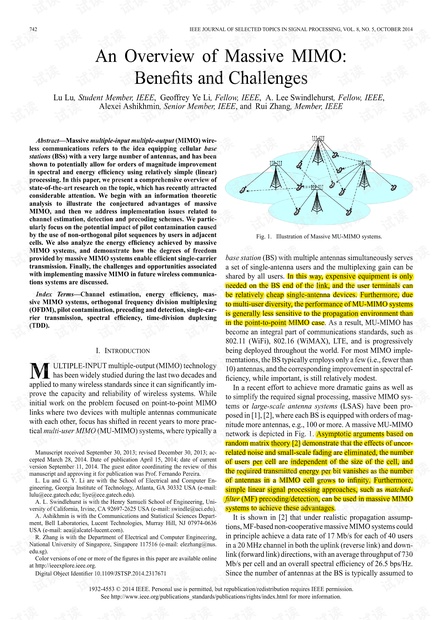Massive MIMO(大规模多输入多输出技术)是一种无线通信领域中的前沿技术,通过在基站安装大量天线来实现显著的性能提升。自提出以来,它就受到了学术界和工业界的广泛关注。在本文中,我们将介绍Massive MIMO的基本概念、优势、实现过程中的挑战以及未来在无线通信系统中实施Massive MIMO的机遇和挑战。 一、Massive MIMO概念和优势 Massive MIMO技术是指在蜂窝基站配备数十至数百根天线,与传统的多输入多输出(MIMO)技术相比,其天线数目更多,因此被称为“大规模”。这种技术通过使用相对简单的线性处理方式,有望使频谱效率和能量效率提高数个数量级。Massive MIMO的优势主要体现在以下几方面: 1. 高频谱效率:增加基站天线数量可以显著提升无线通信系统的频谱效率,使得在同一频谱资源下,通信速率得到极大提升。 2. 高能量效率:大量的天线有助于优化信号的发送和接收过程,减少能耗,从而提高整个系统的能量效率。 3. 更好的信号覆盖和网络容量:由于采用了大规模天线阵列,基站可以同时服务于更多的用户,提高网络容量。 二、Massive MIMO实现中的挑战和问题 Massive MIMO在理论上具有很大优势,但在实际的无线通信环境中面临着诸多挑战: 1. 信道估计:信道估计是指通过已知信息获取信道状态的过程,在Massive MIMO系统中,由于天线数量的激增,信道估计变得更加复杂。 2. 检测和预编码方案:在Massive MIMO系统中,数据的发送和接收需要复杂的检测算法和预编码方案,以确保信号的正确接收。 3. 导频污染:导频污染是指邻近小区的用户使用非正交导频序列导致的干扰问题。在Massive MIMO系统中,由于大量用户同时发送导频信号,导频污染成为需要解决的关键问题。 三、Massive MIMO的能量效率和传输方式 尽管Massive MIMO技术在提高频谱效率方面具有优势,但其对能量效率的提高也是研究的热点之一。Massive MIMO系统中天线的大量增加,为有效实施单载波传输提供了可能。此外,Massive MIMO系统在提供大量自由度的同时,也必须考虑实际部署时所需的硬件和能量消耗,以平衡系统性能和能效。 四、Massive MIMO的未来机遇和挑战 未来无线通信系统中实现Massive MIMO技术,面临着巨大的机遇和挑战。从机遇角度看,Massive MIMO有可能成为下一代通信标准的一部分,帮助实现更高数据速率、更低延迟和更广覆盖的通信网络。然而,挑战也相伴而生,包括需要对现有的无线通信架构进行重大修改、提高基站的计算能力和存储能力、解决大规模天线阵列部署的物理和经济成本等。 五、结束语 Massive MIMO技术是无线通信领域的一项颠覆性创新,它提供了一个在频谱和能效方面实现巨大提升的可能途径。本文从信息论角度分析了Massive MIMO的优势,探讨了实现该技术所面临的挑战,并对未来实施 Massive MIMO系统的机遇和挑战进行了讨论。随着无线通信技术的不断发展,Massive MIMO技术有望在未来的通信系统中发挥关键作用。



剩余16页未读,继续阅读


- 粉丝: 0
- 资源: 1
 我的内容管理
展开
我的内容管理
展开
 我的资源
快来上传第一个资源
我的资源
快来上传第一个资源
 我的收益 登录查看自己的收益
我的收益 登录查看自己的收益 我的积分
登录查看自己的积分
我的积分
登录查看自己的积分
 我的C币
登录后查看C币余额
我的C币
登录后查看C币余额
 我的收藏
我的收藏  我的下载
我的下载  下载帮助
下载帮助

 前往需求广场,查看用户热搜
前往需求广场,查看用户热搜最新资源
- 联合计算铌酸锂微环的Integrated Dispersion:分析超连续谱与光频梳高阶色散的应用研究,Lumerical Mode联合Matlab计算铌酸锂微环的Integrated Dispers
- 基于高频信号注入法的永磁同步电机最大转矩电流比控制算法的在线参数辨识与仿真研究报告-附MATLAB Simulink模型、参考文献及详细说明文档,永磁同步电机控制算法-最大转矩电流比控制(高频信号
- Matlab Simulink下的自抗扰控制(ADRC)算法实现:高效扰动消除与控制系统优化,自抗扰控制(ADRC)算法的Matlab Simulink实现,ADRC算法,自抗扰控制算法的Matlab
- 基于滑模控制的双向Buck-Boost升降压斩波电路及其Cuk电路的Matlab Simulink模型研究:开环闭环策略下的隔离与非隔离双向电路设计,滑模控制双向Buck-Boost升降压斩波电路,c
- linux Miniconda 安装脚本
- 基于模型预测控制(MPC)的PMSM磁场定向控制(FOC)与速度精确控制研究,Simulink-基于模型预测控制对PMSM进行FOC控制,模拟控制了PMSM的速度:基于模型预测控制(MPC)对永磁同步
- 《解锁Cursor:开启高效编程新旅程》,从基础到实战演练
- "MATLAB驱动的直齿轮热弹耦合动力学分析程序:参数输入与结果输出的一站式解决方案",1-220基于matlab的考虑直齿轮热弹耦合的动力学分析,输入主动轮、从动轮各类参数,考虑润滑油温度、润滑油粘
- R工作空间-手写数字识别数据集
- WOA-LightGBM算法:基于鲸鱼优化算法的LightGBM多变量回归预测Matlab程序包,WOA-LightGBM基于鲸鱼算法优化LightGBM的多变量回归预测 Matlab语言 程序已调试
- 基于Matlab Simulink的插电式混合动力汽车四驱PHEV建模与仿真教学:从模型搭建到策略开发的全流程解析,基于Matlab simulink的插电式混合动力汽车建模仿真模型4驱PHEV(比亚
- MATLAB程序视频:双层优化配置模型-含高比例可再生能源配电网灵活资源的运行与规划联合优化算法演示,matlab程序视频:该程序主要方法复现《含高比例可再生能源配电网灵活资源双层优化配置》运行-规
- 基于风光储一次调频的VSG虚拟同步机调频系统:四机两区域离散模型及非无穷大电网的渗透研究与应用定制方案,风光储一次调频,永磁同步风机VSG同步机调频两区域系统,离散模型,非无穷大电网,风机为网侧VSG
- 基于DAB双有源桥的Matlab Simulink仿真:移相技术对减小回流功率的影响及其应用,附带Lunwenviso绘图与Mathtype公式辅助开题报告与PPT演示 ,DAB双有源桥,单移相+双移
- MATLAB Simulink并联P2混合动力汽车仿真模型:策略可优化,操作性强,快速上手学术研究之利器,基于matlab simulink并联p2混合动力汽车simulink仿真模型(整车纯simu
- xitemao.mobileconfig


 信息提交成功
信息提交成功